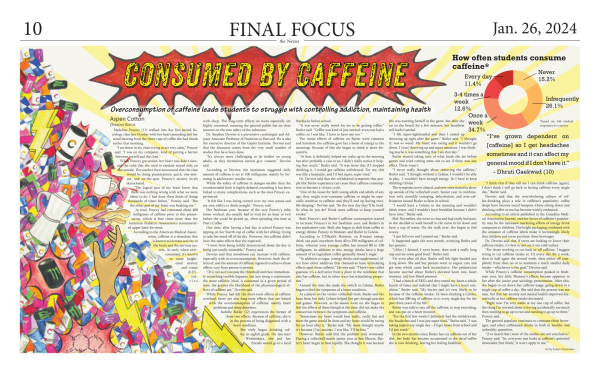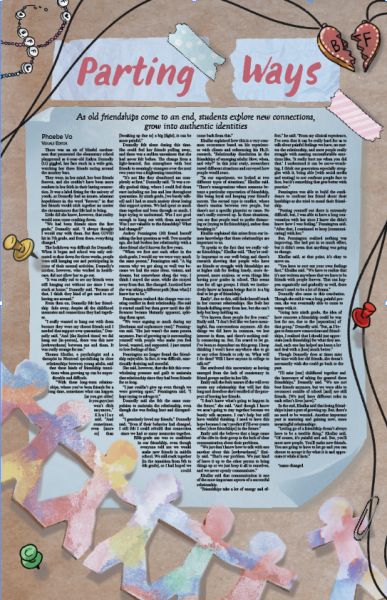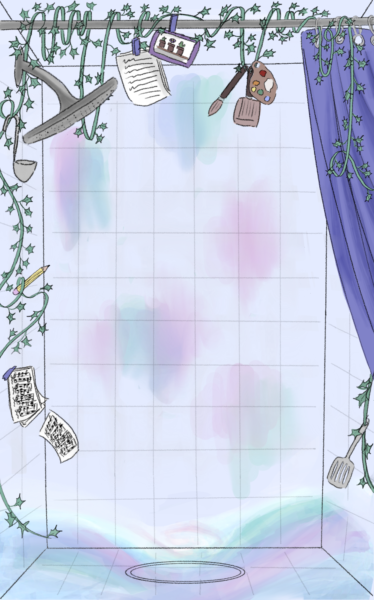Unblurring Boundaries
Existing grey areas in student-teacher relationship policies leave students uncertain of where the line should be drawn

Leah* had always admired her teacher for consistently interacting with his students to make sure they understood the material. Leah thought that he was good at helping those who were struggling in his class, and that he wanted nothing but success for everyone.
“He was an amazing teacher, but it really just got to the point where our relationship was too friendly with one another,” Leah said. “And that’s why I took a really long time to report it.”
Leah said that when her teacher began more frequently calling on her in comparison to other students, she felt like she was being favored. Coupled with mentions of her dresses and skirts in conversation, she began to feel uncomfortable.
“[My friend and I] were always the ones being talked to,” Leah said. “Because I really liked him as a teacher, I tried to [talk] but it got to a point where he would give me snacks and tell me it was just for me. Most days he would give them to everyone, but some days it was just me, and people would look at me funny.”
The last two weeks of the quarter, Leah and her friend stopped going into that teacher’s classroom in-person, opting to Zoom-in to his lessons from a different classroom.
“I was most uncomfortable with being seen by my peers differently,” Leah said. “I didn’t want them to believe that anything was going on, and I didn’t want to be talked about. It felt like he was treating us differently, and it seemed like [he] started to neglect other students. I can’t take a certain class that I really needed to either because of him.”
Leah’s educational opportunities were limited by her teacher’s conduct. Joseph D. Lento specializes in cases like this, founding the Lento Law Firm to protect student rights. Throughout his 20 year career, Lento has encountered cases of varying severities.
“A lot of times, it’s a misunderstanding or difference in perspective in terms of the respondent, [or individual who has been accused of prohibited conduct], may believe that [they are] not doing anything inappropriate, whereas the complainant would be of the opposite mindset,” Lento said. “So a lot of times it’s in those gray areas, where the situation isn’t as clear as if a teacher touches a student’s private parts, where under no circumstances would that be appropriate.”
Lento said that the context in which student-teacher interactions occur is important.
“When you’re a professor teaching a graduate program and you go out for drinks with your class because they’re 25 years old, there is a different kind of dynamic involved,” Lento said. “But with younger students [minors], teachers and staff should be more mindful of the fact that those lines and boundaries are a lot more rigid. So in acting appropriately or reasonably, they should be mindful of the fact that you have to be very careful about crossing boundaries to not even allow the potential appearance of impropriety.”
Leah said that she believes treating all students equally would help to make everyone feel comfortable.
“Within classes, you can see that there’s a favorite and that can not only make it uncomfortable for that person, but also make the other students feel left out,” Leah said. “Overall, I think that incorporating everyone in the lesson and checking in with more than a few students would help. I believe it’s important [teachers] to be aware that their actions could be misconstrued.”
Lento has been involved in numerous cases surrounding Title IX, an educational amendment that prohibits sex-based harrasment and discrimination in any school given government funding.
“In the past 11 years, [Title IX has] become a tool for the enforcement of [policies against] sexual harrasment and sexual misconduct at schools and other institutions,” Lento said. “The [sexual misconduct] doesn’t have to rise to the level of egregiousness, like touching someone inappropriately for it to be sexual harrasment. With Title IX, [one] would examine if the behavior of the teacher is severe and pervasive so the student would have a rightful grievance. It depends on the age of the parties as well, because that can really determine what would be appropriate or crossing the line.”
As a freshman, Ivy* was unsure if her coach’s behavior crossed the line. She didn’t want to cause her coach any trouble, and she would rather just accept that her coach was simply overly talkative.
During the 2019 sports season, Ivy’s coach brought a knife to practice, joking that he would skin someone. He would talk about the number of guns he owned. The joke was lost on Ivy, who was uncomfortable with his mentions of violence.
“He always joked about how he would kick people’s butts,” Ivy said. “If I had reported him, he would have probably been gone, but I think I didn’t report him because I would have felt bad, like it was my fault.”
The following season, her coach continued to reference his guns. However, he began to make additional comments about the athletes’ personal lives.
“Another thing that was uncomfortable was how he would always tell a junior girl and a senior guy to get together, even though the guy had a girlfriend,” Ivy said. “The girl kept telling him to stop, and [that] she was really uncomfortable with it, but he just didn’t stop. But even though he said a lot of weird things, he was a somewhat likable person and I think that’s one of the reasons it took so long for anyone to report him.”
Nathaniel Foote is a partner at the law firm Andreozzi & Foote, based in Pennsylvania. He advocates for survivors of violent and sexual crime in the civil justice system, focusing on cases against institutions such as schools, churches and daycares that have enabled child sexual abuse.
“Every case has different characteristics, but the commonalities I typically see with schools is that the teacher is very well-liked by kids and often popular with their colleagues as well,” Foote said. “In my experience, the way grooming happens is almost universal. It’s personal messages, it’s little comments, or gifts, and it builds over time.”
Foote also works with experts in the fields of sexual assault and harrassment in schools.
“[These experts] just advocate for good policies and adherence,” Foote said. “Don’t spend time alone with a student: have another kid or another adult there. That protects everyone because then there’s a witness [in case of any allegation]. Don’t take students in personal vehicles, don’t communicate with them with personal devices or through social media. Keep the door open: those kinds of [preventitive] policies are really important because they restrict the amount of opportunities [for sexual assualt and harrasment to occur].”
Violations of those boundaries are what Foote looks for when establishing that a school was negligent in protecting students from a teacher or staff member, along with teachers being overly personal with students. Administrative negligence has been pervasive throughout the country, with USA Today reporting that there were “fundamental defects in the teacher screening systems used to ensure the safety of children” in more than 13,000 school districts.
“There are a lot of layers of administration, and often [districts] don’t want to admit [to sexual harrasment], deal with it, or confront it,” Foote said. “They may not want to put the school in a bad light.”
To establish a positive school environment and protect the safety of district students with guidelines that ensure teachers and staff uphold ethical standards and professionalism when interacting with students, the PUSD Board Policy [BP] 4119.24 was adopted October 10, 2019. The policy states that “such adults [with whom students may interact at school or in school-related activities]…shall avoid boundary-blurring behaviors that undermine trust in the adult-student relationship and lead to the appearance of impropriety.”
One example of conduct that can undermine professionalism in these student-teacher interactions that the policy provides includes “singling out a particular student for personal attention and friendship, which could include the giving of gifts and/or assigning nicknames to individual students.”
Principal Tina Ziegler was consulted during the process of drafting this policy.
“We were finding that across the county and even with situations at Westview, there was a blurred line,” Ziegler said. “We realized that if I wanted to talk to a staff member about this, I had no policy to back it up. So that’s why this policy was put in place.”
Ziegler said that perception may play a role when defining the first example the board policy provides of inappropriate conduct: the initiation of inappropriate physical contact.
“If a student reports that there has been an inappropriate or excessive touch, it has to be pervasive,” Ziegler said. “Personnel would investigate it and see what it looked like.”
Lines may be blurred with certain types of physical contact. For instance, with a hug, Ziegler noted that in a celebratory manner, whether that be for an award, athletic event, or graduation, hugging might be deemed an appropriate behavior. However, when unprompted or in a classroom setting, she said it would be worth investigating.
“We actually investigated a situation [where a teacher greeted a student with a hug] and they asked how long it lasted,” Ziegler said. “Sometimes teachers also go around and tap students on the shoulder, and if someone feels uncomfortable, we do say that [the behavior] should stop. And if it’s directed at one person most of the time, that should also be looked into.”
She said that while some of the examples of conduct in the policy are objectively prohibited, others are dependent on the student’s perception.
“The policy outlines no nicknames, but I would think sometimes the nickname is fine,” Ziegler said. “If the student likes it when a teacher calls them that, then it’s fine, but what if they don’t? It’s not that a teacher can never call a person a nickname, but if the student perceives it as inappropriate, then definitely [the guideline would apply]. So it’s both; some [guidelines in the policy] are baseline and never allowed, while others are more dependent on if the student feels uncomfortable.”
For Ivy, the line is drawn when a teacher initiates physical contact, particularly hugs.
“I could definitely see a lot of students being completely fine with hugging a close teacher,” Ivy said. “A lot of situations seem like they would really depend on the context and interpretation. But then again, if the teachers initiate [hugs] that’s probably where the line would be drawn. A teacher has a lot more power, and a student would most likely be pressured into agreeing to the same degree as the teacher.”
Ivy said that she believes defining the policy more clearly would likely help students who are in a similar position as she was to avoid blaming themselves.
“In a lot of these types of [boundary-blurring situations], you could convince yourself that it’s okay,” Ivy said. “If it was clearly written out in the rules, there would be more students speaking out [when they feel uncomfortable] because then they’ll be more aware that this isn’t allowed and it’s very clearly defined.”
Social science and psychology teacher Laura Cox defines emotional boundaries by ensuring that students are aware that she is a mandated reporter—offering support but redirecting conversations that become too specific or personal.
“I want the student to feel supported and listened to,” Cox said. “However, I don’t discuss students’ romantic relationships or even the specific conflicts they may be having with their parents. My suggestions are based on general support and advice, and focused on how a student can take care of themselves in a healthy and constructive way when dealing with stress, anxiety and conflict.”
She based these boundaries of maintaining professional student-teacher relationships on what she feels is appropriate in the context of the conversation.
“I am not a psychologist and if a student needs more support, it is important for me to redirect them to professional support,” Cox said. “I don’t want them to feel like talking to a trusted adult replaces therapy or the medical support they may need. The professional boundary also needs to be maintained. There are close relationships between students and teachers at Westview, and it’s wonderful that students have accessibility to teachers here, but we also need to be aware of how these relationships can be perceived.”
Cox said that a vast majority of teachers never intend to cross a line, but should be aware of sending a message that the student and teacher have a closer relationship in comparison to other students in the class.
“The grooming behaviors as defined now by experts include crossing those lines and talking about things with one student but not the rest of the class, which makes someone separate,” Cox said. “Before this, it had been maintained that there were only certain actions that really cross the line. But as we know now, there are preceding behaviors that are often times warning signs.”
Regardless of intention, Foote emphasizes how it’s important to set careful, clear boundaries to prevent any ambiguity.
“One of the biggest things is just to be careful about spending time communicating outside of the confines of the school day and school building,” Foote said. “Be empathetic, be supportive, and spend time with your students during school, at school. ”
*Names changed












